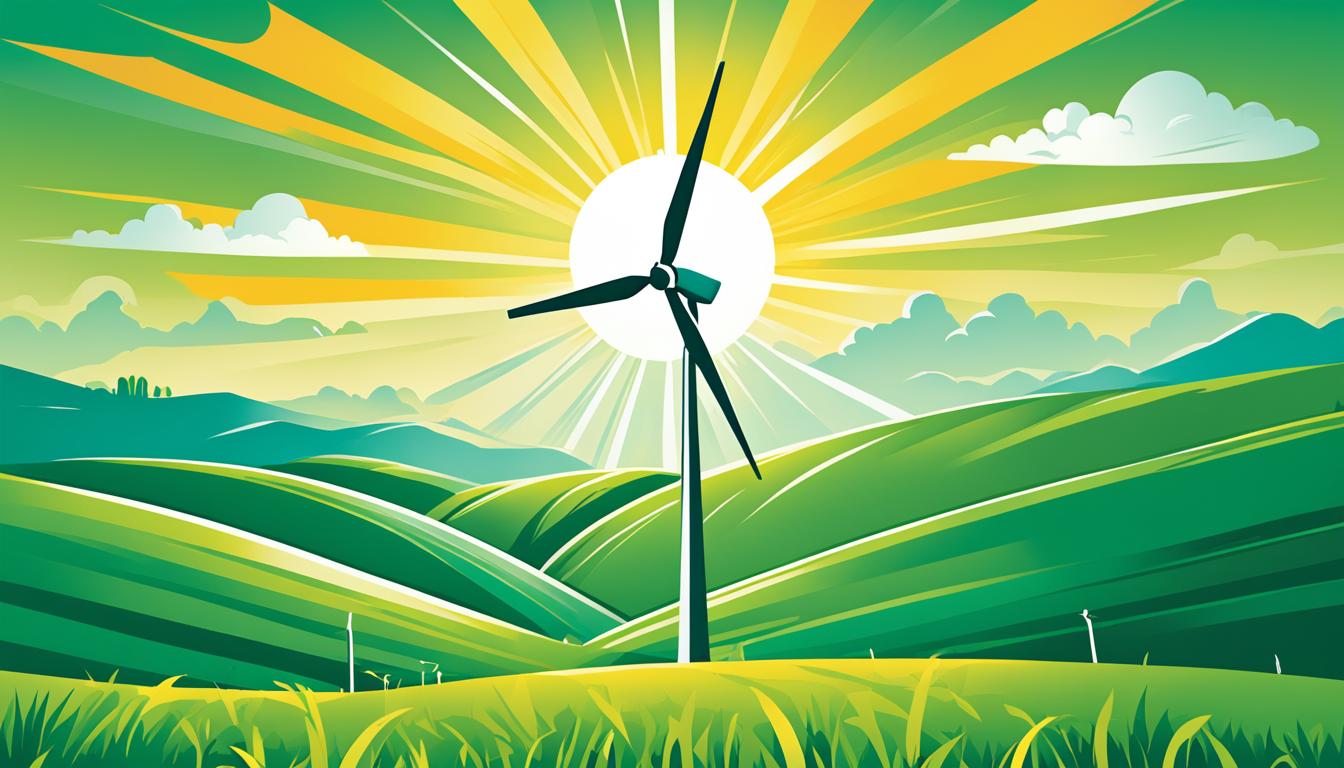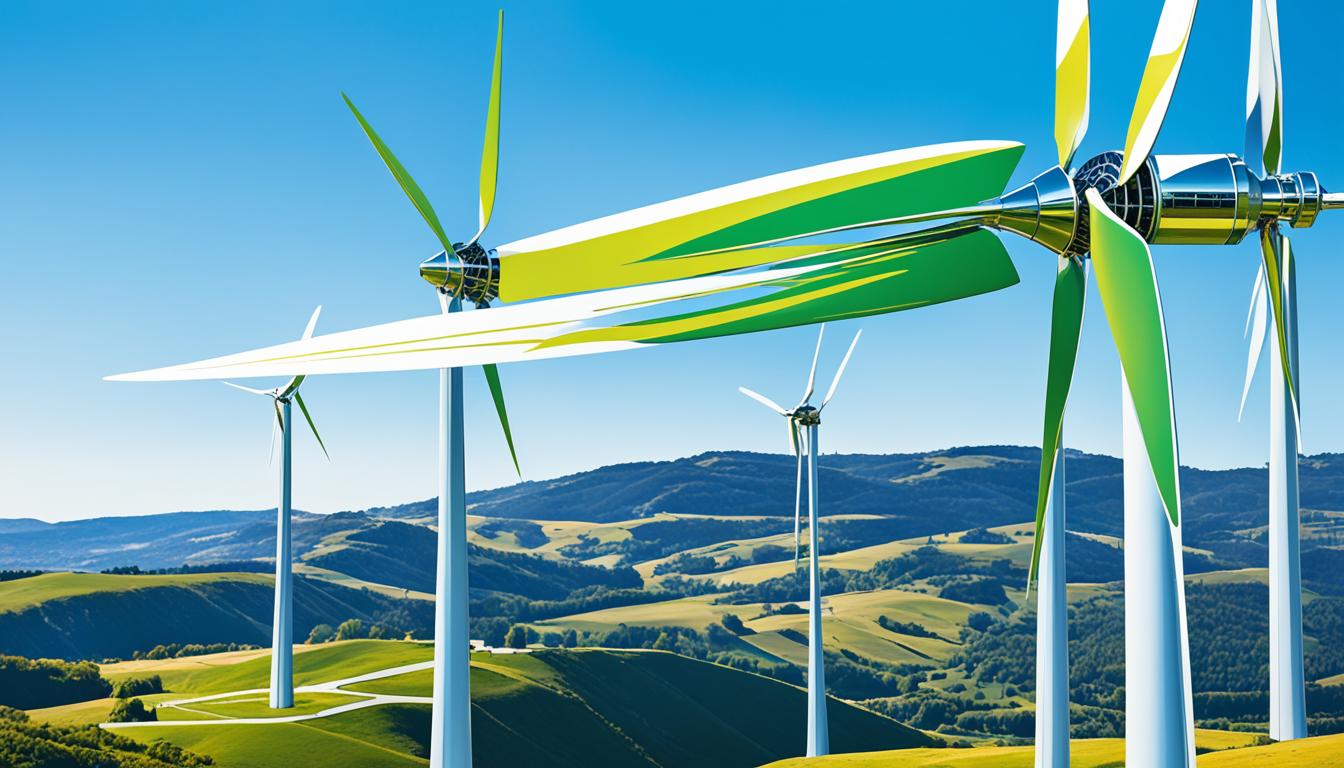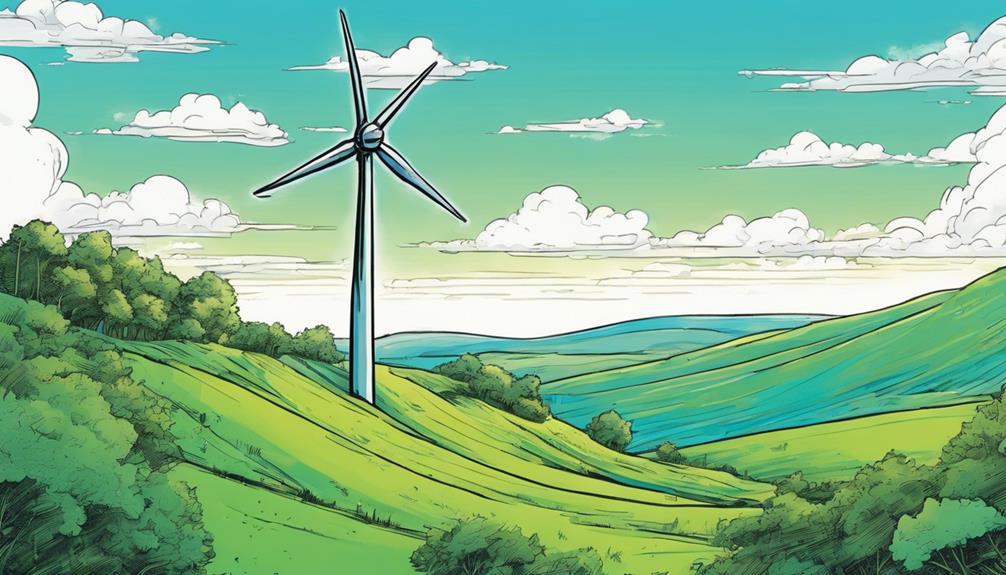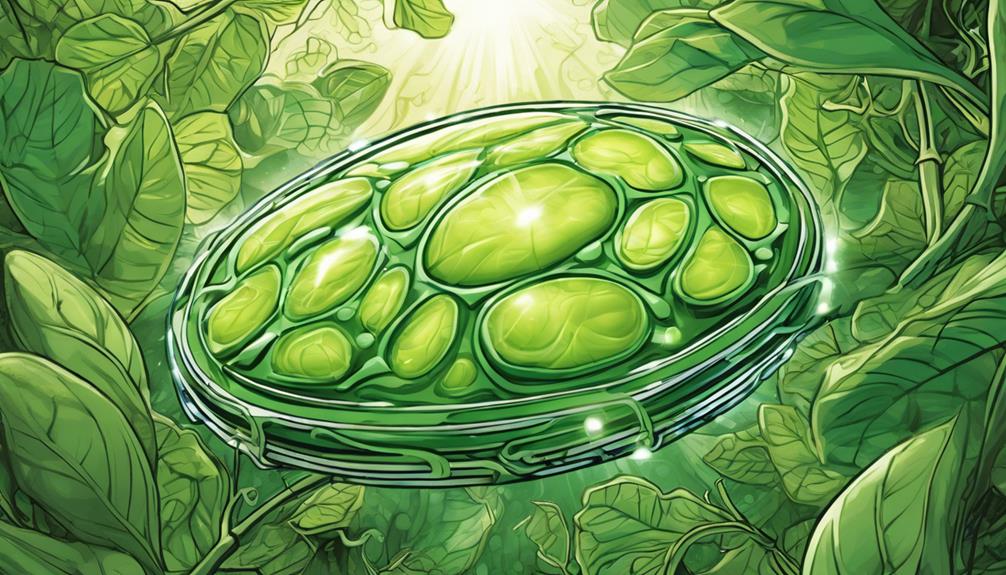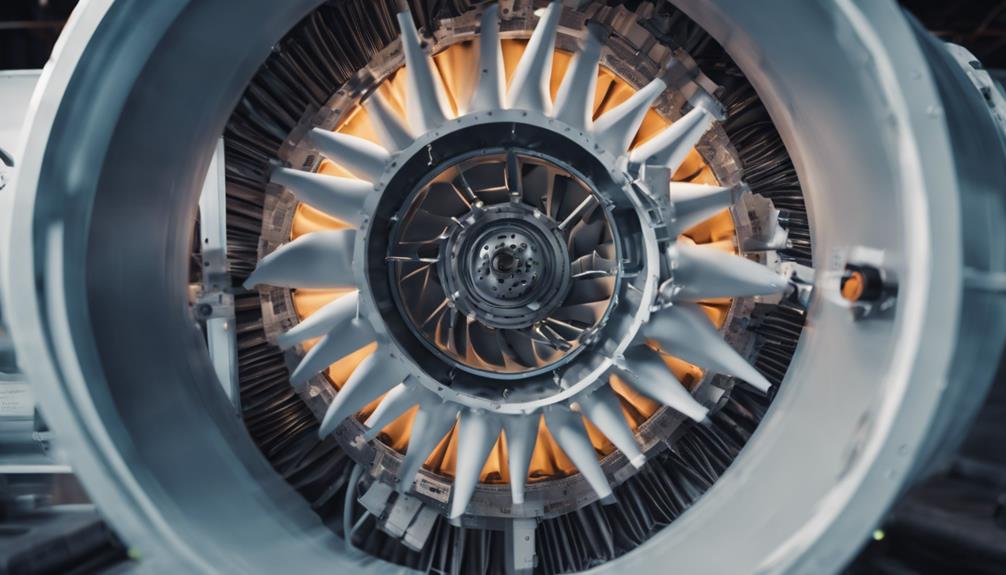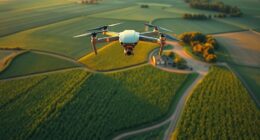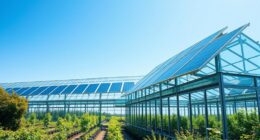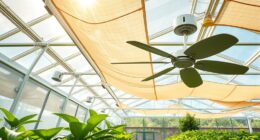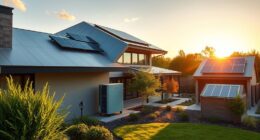Did you know most wind farms in the US are on private, undeveloped rural land1? These projects work by negotiating with landowners to use big areas for wind farming. But, the challenge comes when lands are split into many small pieces. This issue explains why wind energy grows slower in some states.
In comparing states like Wisconsin and Iowa, we notice how land size matters. In Wisconsin, 53% of rural lands are smaller than 100 acres1. Meanwhile, in Iowa, only 35% of lands are this small. Thus, Iowa moves faster in wind energy development than Wisconsin.
Wind developers prefer dealing with fewer owners of big lands1. It makes it easier to build bigger wind farms. But, when lands are owned by many, it’s tough. This often means less wind energy can be produced.
In the US, almost all wind turbines (99.6%) are in rural areas2. They are mostly in micropolitan or non-core counties, making up 62% of turbines. Only 38% are in metro areas2. This shows how much wind energy favors the countryside.
Getting windmills up and running involves many people. Since they’re mostly on private rural lands, it’s key to work well with landowners and the community. This teamwork is vital for both the economy and the environment.
Key Takeaways:
- The majority of wind farms are built on privately owned, undeveloped rural land.
- Land fragmentation with small landholdings can hinder wind energy development.
- There is a preference for areas with few owners of large contiguous tracts of land.
- 99.6% of wind turbines in the U.S. are located in rural areas.
- 62% of wind turbines are in micropolitan or non-core counties.
The Economic Benefits of Wind Energy
Wind energy offers many economic benefits, including job creation. Wind farms create jobs for technicians, engineers, manufacturers, and managers3. They also help businesses involved in maintenance and logistics. This growth brings more job opportunities to the area.
Wind projects also support landowners financially. They lease land, providing a steady income to farmers and ranchers3. This increases landowners’ revenue. Additionally, wind farms boost local tax revenue, benefiting whole communities.
Another advantage is lower electricity prices. Wind energy introduces competition, reducing energy costs for everyone3. Cheaper electricity means people and businesses have more money for other needs. This supports the local economy.
Wind energy’s benefits reach beyond local communities. Manufacturing facilities across the US stimulate national economic growth4. The American Wind Energy Association has found over 500 manufacturing sites. These facilities create jobs and generate revenue, strengthening the economy.
Wind Energy Job Creation Statistics
| Geographic Location | Number of Clean Energy Workers | Number of Workers in Wind Industry | Number of Jobs Created by 50 MW Wind Project |
|---|---|---|---|
| New York | 85,197 | 1,360 | 40 |
| Iowa | N/A | N/A | 2,300 during construction, 270 permanent jobs |
| Illinois | N/A | N/A | 20,173 during construction, 869 permanent jobs |
Wind energy is a big help in creating jobs. In New York, about 85,197 people work in clean energy, with 1,360 in wind3. For example, installing wind capacity in Iowa generated 2,300 jobs during construction and 270 permanent jobs afterwards3. Illinois also saw major job growth from building 25 wind farms, with thousands of jobs created during construction and hundreds of permanent jobs.3.
Overall, wind energy boosts economies by creating jobs, increasing revenue, and lowering energy costs. These benefits help local communities and the national economy. They encourage growth in renewable energy.
Wind Energy Cost and Financing
Starting a wind energy project requires money for the turbines, getting the land, and setting everything up. The cost can change based on the project’s size, the capacity of the turbines, and the type of turbines used.
The price of land-based wind turbines has dropped a lot in recent years. From 2008 to 2020, their cost fell by 50%, hitting around $850 to $950 per kilowatt by 20225.
The initial costs for these wind energy projects have stayed stable since the early 2000s. After dropping 40% from their highest in 2009, these costs are now $1,200 to $1,800 per kilowatt (kW)5.
To help with wind energy growth, governments give out tax breaks, grants, and loans. For example, the Inflation Reduction Act extended tax credits for wind projects until 20246. Also, a program from 2009 offered a 30% cash grant for the cost of projects built by end of 20126.
Owners of wind projects can save money through fast depreciation. With the MACRS, they can write off most costs over 5 years6. Also, the Rural Energy for America Program gives loans and grants to help farmers, ranchers, and local governments develop renewable energy6.
Paying for a wind energy project involves personal funds, tax investors, and borrowed money. The cost to finance it is affected by interest rates and how it compares to other investments7. There are risks from the economy, the market’s risk tolerance, and specific wind industry challenges7.
Wind farms bring in steady money over time through taxes paid to governments. This helps the local economy and supports a cleaner, sustainable future by turning wind into affordable energy.
Wind Energy and Job Creation
Wind energy is playing a vital role in job creation, providing substantial employment opportunities in the United States.
The wind energy industry employed over 125,000 workers in 2022. This shows its big role in the economy8.
These employment opportunities aren’t just in turbine installation and maintenance. They also spread to various other sectors. Wind energy projects create a ripple effect. They generate additional job opportunities indirectly, such as in supply chain management, financial analysis, engineering, and service industries8.
Wind turbine service technicians are the fastest-growing job in the U.S. for the decade. This is according to the U.S. Bureau of Labor Statistics9. It shows the growing need for skilled workers in the wind industry. It also points to the strong career prospects it offers.
Wind turbines work across all 50 states. They accounted for over 10% of the total energy produced in the United States in 2022. This shows the industry’s impact on jobs and the move toward a cleaner, sustainable energy future9. The industry’s growth and investments in new projects add billions to the U.S. economy. This creates more jobs and positive economic impacts9.
Besides, wind energy helps reduce carbon dioxide emissions. It prevents about 336 million metric tons of carbon dioxide emissions annually. That’s like taking around 73 million cars off the road9. By using wind energy, the U.S. lessens its environmental impact. This creates jobs and boosts economic growth at the same time.
Wind projects help with employment and economic growth. They also provide crucial state and local tax payments. Every year, wind projects contribute about $2 billion in state and local taxes. This supports local communities and governments9. Plus, wind energy projects on private land offer big land lease payments. In 2022, an estimated $935 million was paid to rural landowners. This gives income to landowners and supports local economies in rural areas8.
The wind energy industry is committed to being cost competitive. It can work in different settings. Its growing role in the energy sector makes it a big source of jobs, economic growth, and environmental sustainability in the United States.
Community Wind Energy Projects
Community wind projects are owned locally. They involve farmers, investors, schools, and more. These projects strengthen and support communities by offering economic benefits.
Community wind projects bring more jobs than those not owned locally. This is during construction and operation. It boosts the local economy.
They also give locals more control. People get to decide on important aspects of the project. This makes sure the projects meet local needs and values.
Owners of these projects enjoy financial benefits. With predictable costs, they offer economic stability. This encourages more local investment.
These projects have strong community support10. They are by the people, for the people. This support drives renewable energy use in the area.
Community wind projects are also good for the environment. They reduce air pollution and the risk of contamination. They help keep natural resources safe.
They can lead to lower energy costs, especially where fuel is expensive. By producing energy locally, communities depend less on outside sources. This offers a more reliable and cheaper energy supply.
Community wind projects empower local ownership and drive economic growth. They are key in moving towards clean energy. They help create stronger, sustainable communities.
Wind Farms and Land Lease Agreements
Wind energy companies often lease land from rural landowners for wind farm development. This provides an additional income for landowners. It also helps increase renewable energy use. Landowners get paid for allowing access to their land and sharing in the wind farm’s revenue. This ensures a win-win situation.
Land lease payments vary by many factors. These include property size, location, and the number of wind turbines on the land. Owners might get $50 to $200 per acre annually for an Option Agreement. This gives exclusive rights for 2-5 years before a formal lease is made11.
Under these agreements, payments to landowners can be fixed, revenue-based, or both. A single wind turbine lease might pay about $8,000 yearly. Larger turbines can earn $50,000 to $80,000 annually11. These payment structures aim to fairly compensate landowners, considering the project’s revenue potential.
Wind farms take up little space. This means most of the land can still be used for farming or other activities11. It’s a big plus, allowing landowners to benefit from wind projects without giving up their primary activities.
Lease Agreement Considerations
Before entering a wind farm lease, landowners should weigh several things. Developers want to use as much land as possible to make the project more efficient. They aim for economies of scale to cut costs12. Also, the placement and possible obstructions to wind turbines can affect energy production. Thus, developers include clauses in agreements to manage structure placement and avoid obstructions12.
Landowners should negotiate terms to protect their interests, especially in agriculture. These terms help ensure they can keep using their land as they wish12.
Leases, Royalties, and Duration
Until the wind farm generates electricity, developers pay landowners $5 to $40 per acre yearly13. Royalty rates often start at 4% and may reach 10% over 20 years13. Payments per turbine can be $5,000 to $8,000 per megawatt produced13. Typically, wind lease agreements last 20 to 25 years, with extension options13.
In addition to revenue-based royalties, landowners may get a fixed rent from developers. This ensures a steady income on top of any revenue shares. Landowners can also sell future wind rental payments through platforms like LandGate13.
Global Examples of Community Wind Projects
Community wind projects are popular around the world, with notable examples in several countries. For instance, Australia boasts the Hepburn Wind Project, its first community-owned wind farm. In Canada, there’s the unique Pukwis Community Wind Park, a collaboration between Aboriginal groups and the local community.
Denmark has a rich history of community wind farms, thanks to wind cooperatives. These groups have been key in advancing the nation’s wind power sector14. Meanwhile, in Germany, community wind projects have flourished. Hundreds of thousands have invested in citizen-operated wind farms14.
India’s villages have seen benefits from community-owned wind projects, aiding in energy self-reliance15. The Netherlands also has a thriving community wind cooperative scene. These cooperatives are dedicated to developing and managing wind parks by the communities themselves15.
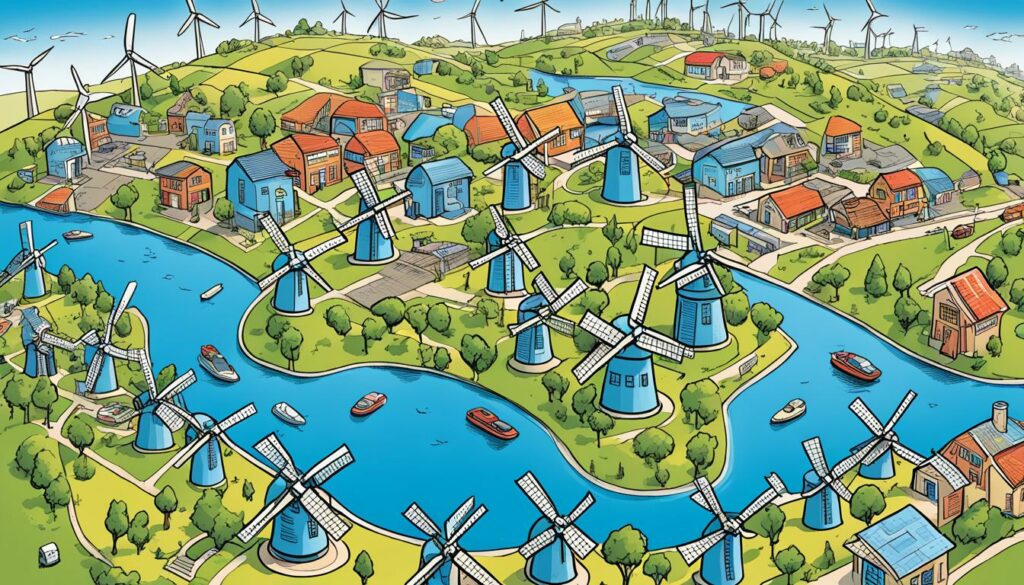
Wind Energy and Local Revenue Generation
Wind energy brings important financial benefits to local areas. It boosts economic growth and financial health. Through development fees, tax payments, and benefits deals, these projects add money into local communities.
Building a wind project takes about 8-10 months. Large projects may need more time. This is due to their size and local weather16. During construction, a 100-megawatt project supports 80-100 jobs16. For example, a 600-megawatt project in Colorado created 245 construction jobs16.
Once they’re running, wind projects need 2 to 16 people for maintenance16. These jobs help the local economy. Over 80% of this income goes back into local businesses16. This spending also creates more jobs, ranging from 0.003 to 0.145 jobs per megawatt, depending on the community’s economy16.
Studies show wind turbines raised local incomes by about 5% and home values by 2.6% in some U.S. areas17. Wind power helps local governments earn more money per energy unit than fossil fuels in many states18. It also increased home values by 2.6% in counties with turbines17.
Wind energy is especially good for rural U.S. regions17. In some fossil fuel-heavy areas, government revenue can be more than $1,000 per person annually. It could even be over $10,000 in some spots18. For a similar income from renewables, these areas would need 14% to 66% of land for solar farms18.
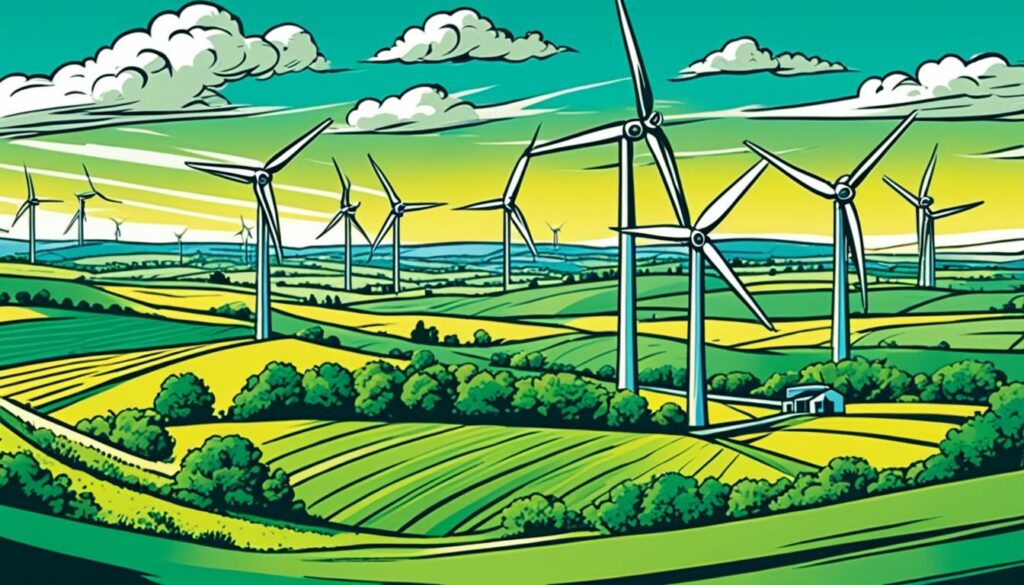
Wind power also increases income and GDP per capita where turbines are put up. A 100 MW wind farm can raise incomes by over $300 per person. It can also boost median home values by more than $400*/
While wind projects might not stop population drops in rural areas, they offer a new income source17. Wind power’s effect on overall jobs is small. However, it shifts jobs from farming to construction17.
To conclude, wind energy projects create many benefits. They support job growth, boost incomes and property values, and encourage economic development everywhere.
Wind Energy and Environmental Impact
Wind energy is a great source of power that doesn’t harm our planet. It’s much better for the environment than old-school energy like oil or gas. That’s because it doesn’t release nasty gases that heat up our Earth. Using the wind to make electricity is a cool way to help stop climate change and make the air cleaner.
When it comes to keeping the air clean, wind energy is top-notch. It doesn’t make much pollution at all. This means it’s a super choice for protecting our planet. Plus, wind farms are pretty easy on the land. They don’t take up much space and can exist happily alongside farms. They also don’t need a lot of water, so they’re kinder to our precious water supplies than other energy sources are.
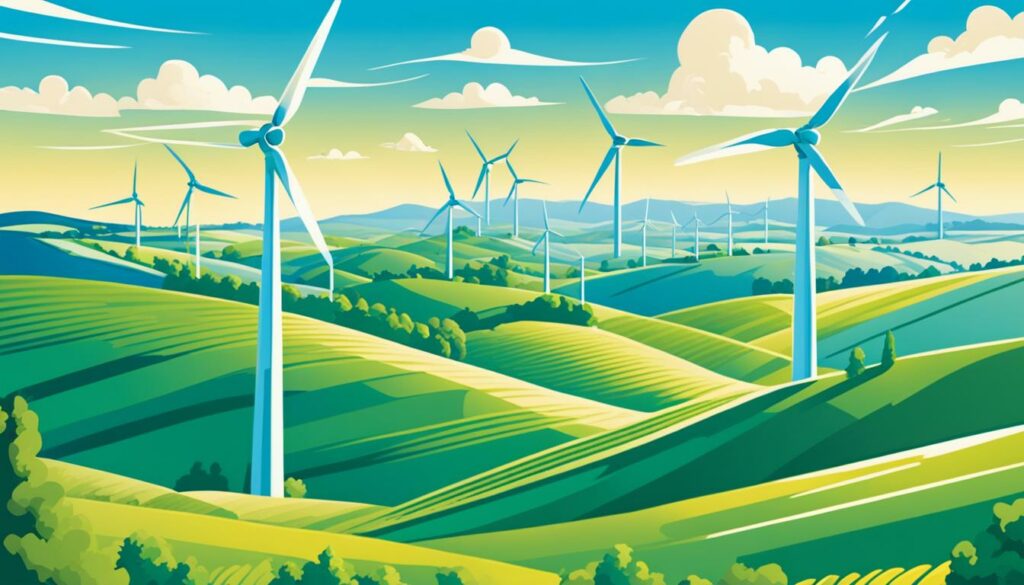
But, even with all its perks, wind energy has some downsides we can’t ignore. For example, wind farms on land can be big and change the look of natural places. They need a lot of room and can sometimes upset people who love the beauty of those areas. We have to be smart about where we put wind turbines to avoid hurting the scenery.
We also need to watch out for wildlife when building wind farms. Even though wind turbines are way better than fossil fuels for birds and bats, we still need to be careful. We have to make sure our green energy doesn’t harm their homes. And yes, wind turbines can be noisy, but the noise isn’t usually a problem if they’re placed far enough away from where people live.
There’s also the issue with the turbine blades. They don’t last forever and can be tricky to get rid of. But, good news, people are working on ways to recycle them. Wind energy is also great because it doesn’t contribute much to global warming. It helps us fight climate change without making a lot of noise or mess.
Wind energy is really taking off in the U.S., bringing lots of good things like jobs and cleaner air. The government and businesses are all in on making wind power even better. They’re finding ways to make it cheaper and less harmful to animals. This means we can look forward to a cleaner, greener future thanks to wind power.
| Statistical Data | Reference |
|---|---|
| An estimated 0.02 and 0.04 pounds of carbon dioxide equivalent per kilowatt-hour are emitted during the life-cycle of wind turbines. | 19 |
| Wind energy has one of the least greenhouse gas emissions per energy source. | 20 |
| Wind power plants have low environmental impact compared to fossil fuel power plants. | 20 |
| Onshore wind farms may have a significant visual impact and require more land. | 20 |
| Wind farms can lead to conflicts, especially in scenic areas. | 20 |
| Habitat loss and fragmentation are potential impacts of onshore wind farms on wildlife. | 20 |
| Wind power has one of the lowest global warming potentials per unit of electricity generated. | 20 |
| Wind turbine blades are commonly made of fiberglass and have a lifespan of 10 to 20 years. | 20 |
Government Role in Wind Energy Development
Governments are key in boosting wind energy use. In the U.S. and elsewhere, goals and benefits help wind energy grow. They set renewable energy targets and use incentives. Wind energy policies ease the creation of wind farms and offer money help. Land owned by the government is great for wind projects. Offshore wind areas are also looked at more now, as they have less issues with land rights.
“WETO works on making wind plants better in design, location, and how they operate. They tackle the costs and problems faced by smaller wind turbines. By assessing environmental impacts and integrating wind power into the grid, they reduce barriers. They push forward offshore wind, improve next-gen wind tech, and back resource studies. Their efforts include building facilities to test wind tech, working with suppliers for better reliability and costs, solving radar issues, promoting sustainability, and investing in education within the wind industry.”21
WETO has backed many projects, pushing wind energy forward. They have publications that share their findings with those interested. The “Wind Success Stories” page talks about how WETO helped wind power get better and spread faster.
The OSTI, part of the Department of Energy, has a vast collection of research. This includes studies on wind energy funded by the DOE.
Wind power in the U.S. went from under 1% in 1990 to over 10% in 2022. In 1990, 16 countries made around 3.6 billion kWh of wind power. By 2021, over 128 countries made about 1,808 billion kWh. China leads in wind power, thanks to huge investments in wind energy22.
State and local governments also support wind energy. The U.S. saw a huge rise in wind power from 2000 to 2016. Between 2005 and 2009, wind capacity grew by 39% every year. Since 2000, 24 states have passed Renewable Portfolio Standards (RPS) to push for more renewable energy. These policies show both parties working together. For example, Texas leads in wind capacity, while California pushes for renewable energies. Even states with different political views, like Iowa, have made big strides in wind energy. This shows that wind energy has support across the board23.
The government’s push for wind energy is key to meeting energy goals and fighting climate change. With the right policies and support, governments can make our future cleaner and sustainable.
Conclusion
In the U.S., wind energy mainly belongs to private individuals and groups. The way land is divided and lease deals are made plays a big role. This affects who owns the windmills.
Wind energy brings big economic perks. It helps create jobs and brings more money to local places. The wind sector has grown with the help of U.S. government tax breaks. These breaks have given nearly $25 billion since 2010.
Governments around the world are focusing on renewable energy, like wind, to fight climate change. They want to make the environment better. Wind energy’s role in the U.S. has jumped from almost nothing in 2000 to about 7% by 20182425. The wind sector aims to supply 6% of the U.S.’s energy by 202025.
Wind energy has a bright future but it’s not without its hurdles. Finding the right places for wind farms and getting different landowners to work together can be tough. Yet, because wind energy is getting more cost-effective and technology is improving, the outlook is good. Government support also helps a lot2425.
